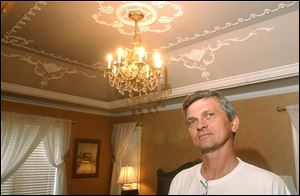
Outside the usual mold
10/3/2004
Aleksey Syrnichenko has crafted plaster embellishments for several Toledo-area homes, including this one in Springfield Township.
In an attempt to break away from the cookie-cutter look of many suburban houses' interiors, some designers are reaching into the past to a craft that many had given up for lost.
Decorative plaster, the old art of adding dimension and flair to ceilings and other surfaces, is making a comeback.
"A lot of it is on the higher-end side," said Paul Gunther, president of the New York-based Institute of Classical Architecture. "But from our perspective, it's a fact that there is a greater interest in its application and execution."
Another sign of its resurgence: In some regions of the country, home-building stores catering to the do-it-yourselfer, including Home Depot, have begun to carry pre-fabricated pieces, Mr. Gunther said.
Russian-born Aleksey Syrnichenko, whose Maumee firm specializes in decorative plaster, has been involved in a number of projects locally in recent years.
The work has been concentrated in dining rooms and master bedrooms and on fireplaces. One customer, explaining his motivation for seeking the work, told the craftsman: "There is nothing to lay your eyes on. Everything is so similar, so neutral, so safe."
"It's not for regular houses," Mr. Syrnichenko conceded, noting that most of his work is restoration projects in historic homes and upper-end new construction.
His goal, he said, is to keep designs "simple but elegant."
"My father, when he taught me in Russia, said, 'Don't overdo it.' In any project, the most important thing is to know when to say 'enough.' "
He is critical of pre-fabricated medallions and other faux plaster objects sold commercially, saying some of them are fashioned from foam.
One client came to Mr. Syrnichenko's Olyana Magic Plaster Inc. after touring a home on which he had worked that was part of a house show sponsored by the Home Builders Association of Greater Toledo.
The couple asked him to coordinate a ceiling at their Stone Oak home with an elaborate chandelier they had purchased. The outcome, involving a square divided into segments and festooned with green leaves against a sky-blue background, was dubbed "spring year-round" by the craftsman.
Demand for the work is not high in Toledo, partly because it can be pricey, but also because few people are aware of it, said Mr. Syrnichenko, 46.
"Nobody offers it, so nobody is expecting it."
Mr. Syrnichenko was reluctant to discuss price. But an industry official in Toronto whose firm is involved in such work said prices can range from $1,000 for a simple cornice around a dining room ceiling to $10,000 for more elaborate designs and carvings.
Mr. Syrnichenko is awaiting word on two new homes in which he has bid.
Builders, he noted, play a key role in the selection process. And they are price-conscious even with expensive homes.
Still, many homeowners across the country have decided it is worth the extra expense.
"There is somewhat of a renaissance in traditional design," explained Mr. Gunther, of the Institute of Classical Architecture.
"There is no question that is partly a response to cookie-cutter suburbia."
David Flaharty, a nationally respected decorative plasterer in Pennsylvania who has done work at the White House, said he has seen an increase in demand in both new commercial and residential construction.
Ornamental plasterers thrived in the United States from the mid-18th century to the Depression years of the 1930s, according to Mr. Flaharty.
"During this 200-year period, as the Georgian and Federal styles yielded to the revivals - Greek, Rococo, Gothic, Renaissance, and Spanish - decorative plaster reflected each style, resulting in the wide variety of ornamentation that survives," he wrote in a historic preservation publication sponsored by the National Park Service.
The craft developed from sole practitioners in the 1700s to multiple-employee shops in the early 20th century.
Peter Pennoyer, an architect in New York, incorporates ornamental plaster extensively in home designs.
He credits the historic preservation movement with promoting interest in plaster among architects.
Although he agrees that it most often is used in higher-end residences, he said it is not merely impractical decoration. "It becomes fused to the ceiling," he explained.
"Unlike wood molding, especially in areas with heating and cooling cycles, plaster moldings don't expand and contract. The paint goes on easier."
Felber Ornamental Plaster Corp., Norristown, Pa., supplies pre-cast cornices, medallions, and other items to builders for 100 to 150 houses each year, said Ted Ottey, controller.
In some cases, the products are destined for mansions of 18,000 square feet or more.
But not all of the firm's customers are wealthy.
"We had a woman from Albany, N.Y., who drove down to our shop," recalled Mr. Ottey. "She just loves plaster. She bought a cornice and loaded it into her Volvo."
Real-estate investor Joe McCormick, a former Maumee resident now living in Cincinnati, has been pleased with decorative plaster he has had installed in three homes he has owned. He credits the work with speeding the sale of two of the properties.
"It creates a classic, conservative look," he said.
"You can spend a lot of money on a new home and it still looks like a tract home. This personalizes a home. It's more like a home built at the turn of the century or in the 1920s."
Contact Gary Pakulski at: gpakulski@theblade.com or 419-724-6082.